

The Carbon Dioxide Greenhouse Effect. Isotope. The three naturally-occurring isotopes of hydrogen.

The fact that each isotope has one proton makes them all variants of hydrogen: the identity of the isotope is given by the number of neutrons. From left to right, the isotopes are protium (1H) with zero neutrons, deuterium (2H) with one neutron, and tritium (3H) with two neutrons. Isotopes are variants of a particular chemical element such that, while all isotopes of a given element have the same number of protons in each atom, they differ in neutron number.
The term isotope is formed from the Greek roots isos (ἴσος "equal") and topos (τόπος "place"), meaning "the same place". James Croll. James Croll, FRS, (2 January 1821 – 15 December 1890) was a 19th-century Scottish scientist who developed a theory of climate change based on changes in the Earth's orbit.
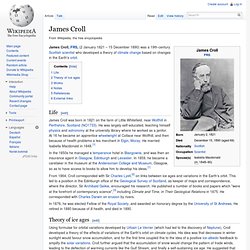
Life[edit] James Croll was born in 1821 on the farm of Little Whitefield, near Wolfhill in Perthshire, Scotland (NO1733). He was largely self-educated, teaching himself physics and astronomy at the university library where he worked as a janitor. At 16 he became an apprentice wheelwright at Collace near Wolfhill, and then because of health problems a tea merchant in Elgin, Moray. He married Isabella Macdonald in 1848. In the 1850s he managed a temperance hotel in Blairgowrie, and was then an insurance agent in Glasgow, Edinburgh and Leicester.
From 1864, Croll corresponded with Sir Charles Lyell,[2] on links between ice ages and variations in the Earth's orbit. Milutin Milanković. Joseph Fourier. Biography[edit]
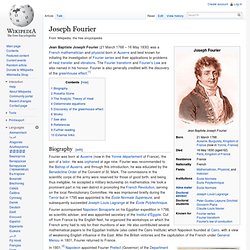
Greenhouse effect. A representation of the exchanges of energy between the source (the Sun), the Earth's surface, the Earth's atmosphere, and the ultimate sink outer space.
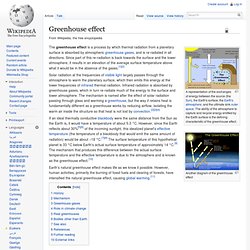
The ability of the atmosphere to capture and recycle energy emitted by the Earth surface is the defining characteristic of the greenhouse effect. Another diagram of the greenhouse effect The greenhouse effect is a process by which thermal radiation from a planetary surface is absorbed by atmospheric greenhouse gases, and is re-radiated in all directions. Claude Pouillet. Claude Servais Mathias Pouillet (16 February 1791 – 14 June 1868) was a French physicist and a professor of physics at the Sorbonne and member of the French Academy of Science.
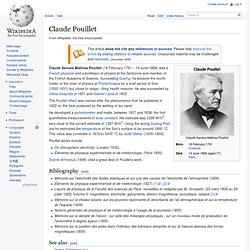
Succeeding Dulong, he became the fourth holder of the chair of physics at Polytechnique for a brief period of time (1830-1831) but chose to resign, citing health reasons. He was succeeded by César Despretz in 1831 and Gabriel Lamé in 1832. The Pouillet effect was named after the phenomenon that he published in 1822 on the heat produced by the wetting of dry sand. He developed a pyrheliometer and made, between 1837 and 1838, the first quantitative measurements of solar constant. His estimate was 1228 W/m2, very close to the current estimate of 1367 W/m2.
Pouillet works include: On atmospheric electricity, (London 1832),Éléments de physique expérimentale et de météorologie, (Paris 1856). Svante Arrhenius (1896) cited a great deal of Pouillet's work. Bibliography[edit] See also[edit] References[edit] John Tyndall. John Tyndall FRS (2 August 1820 – 4 December 1893) was a prominent 19th century physicist.

Svante Arrhenius. Biography[edit] Early years[edit] Arrhenius was born on February 19, 1859 at Vik (also spelled Wik or Wijk), near Uppsala, Sweden, the son of Svante Gustav and Carolina Thunberg Arrhenius.
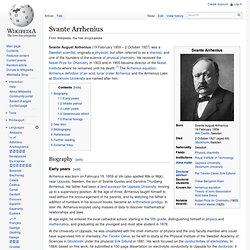
His father had been a land surveyor for Uppsala University, moving up to a supervisory position. At the age of three, Arrhenius taught himself to read without the encouragement of his parents, and by watching his father's addition of numbers in his account books, became an arithmetical prodigy. In later life, Arrhenius enjoyed using masses of data to discover mathematical relationships and laws. Greenhouse Effect.svg - Wikipedia, the free encyclopedia. Inadvertent climate modification. Climatic Change: Are We on the Brink of a Pronounced Global Warming? Charneyreport.brian. Jimmy Carter: Address to the Nation on Energy. Good evening.

Tonight I want to have an unpleasant talk with you about a problem that is unprecedented in our history. With the exception of preventing war, this is the greatest challenge that our country will face during our lifetime. The energy crisis has not yet overwhelmed us, but it will if we do not act quickly. It's a problem that we will not be able to solve in the next few years, and it's likely to get progressively worse through the rest of this century. We must not be selfish or timid if we hope to have a decent world for our children and our grandchildren. Two days from now, I will present to the Congress my energy proposals.. Many of these proposals will be unpopular. Global warming. Global mean land-ocean temperature change from 1880 to 2014, relative to the 1951–1980 mean.

The black line is the annual mean and the red line is the 5-year running mean. The green bars show uncertainty estimates. Source: NASA GISS. ClassicArticles/GlobalWarming/Article4 - NSDLWiki. On the Influence of Carbonic Acid in the Air upon the Temperature of the Ground Arrhenius, Svante, 1896.

On the Influence of Carbonic Acid in the Air upon the Temperature of the Ground. Philosophical Magazine ser. 5, vol. 41, 237–276. Article Link Essay about this article.